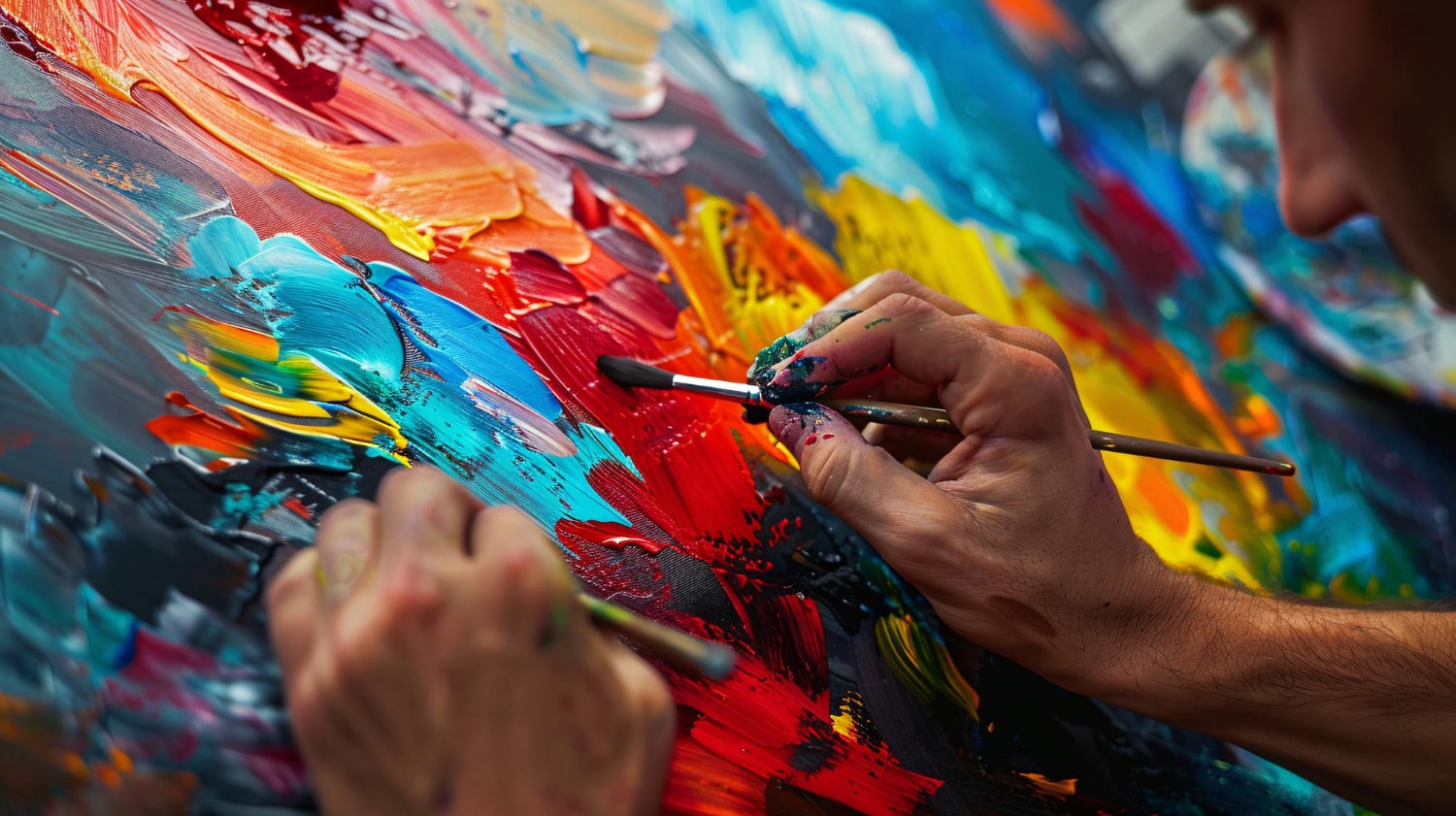How Artists Can Sell Art Online: Website, Social Media & Ad Strategy
The internet has completely transformed how artists sell their creations. Gone are the days when you had to depend only on galleries or exhibitions to showcase your work. Today, with a powerful website, strategic social media marketing, and targeted ads, any artist can build an audience, gain visibility, and make consistent sales.
In this guide, we’ll explore how to sell art online effectively — from designing your art website or landing page, to building a social media plan with static posts, reels, carousels, and running sales-driven ad campaigns.

🎨 1. Why Artists Should Sell Art Online
Selling art online gives artists creative independence and business freedom. Here’s why every modern artist should go digital:
- 24/7 Global Exposure: Your art can reach collectors around the world.
- Direct Connection with Buyers: Build relationships without middlemen.
- Personal Brand Growth: Create an identity as an independent artist.
- Multiple Income Streams: From selling originals to prints, NFTs, and commissions.
🌐 2. Building a Website or Landing Page to Sell Art
Your website is your digital art gallery — a space that represents your brand and creativity. It should be clean, visually engaging, and user-friendly.
Key Elements for an Artist’s Website or Landing Page
- Homepage:
- Eye-catching banner or slideshow featuring your best artworks.
- A short, compelling intro about who you are and your art style.
- A clear “Shop Now” or “Explore Art” button.
- About Page:
- Your artistic journey, inspiration, and creative process.
- Add your portrait or behind-the-scenes photo to connect personally.
- Gallery/Portfolio:
- Showcase high-quality images of your art.
- Categorize works by theme, size, or collection for easy browsing.
- Product/Shop Page:
- Include artwork details — size, medium, price, availability.
- Offer options for framed/unframed or print versions.
- Add secure checkout (PayPal, Stripe, Razorpay).
- Testimonials & Reviews:
- Display client feedback, collector stories, or media features.
- Contact Page:
- Include an inquiry form, email, WhatsApp, and social links.
- SEO Optimization:
- Use keywords like “buy modern art online,” “Indian artist paintings,” etc.
- Add meta tags and alt text for each artwork image.
- Blog Section (Optional but Powerful):
- Share art tutorials, creative process, or art market insights.
- It helps with Google ranking and builds trust.
📱 3. Social Media Marketing Plan for Artists
Social media is where people discover your art. It’s your digital exhibition space that brings your creations in front of the right audience.
The key is consistency and variety — mixing static posts, carousels, reels, and stories.
Here’s a monthly social media plan for artists 👇
| Content Type | Posts per Month | Purpose | Example Ideas |
|---|---|---|---|
| Static Posts | 8–10 | Show finished artworks, new arrivals, quotes | Artwork showcase, painting detail shot |
| Reels | 8–12 | Show process, behind the scenes, or storytelling | “Making of an abstract painting,” time-lapse art |
| Carousel Posts | 4–6 | Educational or storytelling content | “5 steps of my painting process” |
| Stories | Daily (20–25/month) | Engage and interact | Polls, Q&A, studio updates |
| Sales/Offer Posts | 3–4 | Promote limited edition or discounts | “Get 20% off on first art print” |
Weekly Content Mix Example
| Day | Content Type | Example Topic |
|---|---|---|
| Monday | Reel | Painting time-lapse |
| Tuesday | Static Post | Featured artwork |
| Wednesday | Carousel | “Story behind this painting” |
| Thursday | Story | Studio moment or work-in-progress |
| Friday | Reel | Art tutorial or voice-over message |
| Saturday | Static Post | Collector testimonial |
| Sunday | Carousel | “Art care tips” |
Social Media Tips for Artists
- Use natural light when photographing your art.
- Tell stories — people buy emotion, not just artwork.
- Use relevant hashtags (#ArtForSale #ContemporaryArt #ArtistOnInstagram).
- Engage daily: reply to comments, share stories, and thank buyers.
- Collaborate with other creators, art pages, or galleries.
💡 4. Paid Ads Campaign for Selling Art
Organic reach is great for building awareness, but to get consistent buyers, you need a smart ad strategy. Paid ads help you reach collectors, art lovers, interior designers, and businesses who purchase art for offices or décor.
Platforms for Ads
- Facebook & Instagram Ads: Best for visual storytelling and discovery.
- Google Ads: Ideal for targeting people actively searching “buy modern painting online.”
- Pinterest Ads: Great for art lovers and interior design enthusiasts.
Ad Campaign Goals
- Brand Awareness Ads:
- Objective: Reach new audiences and grow followers.
- Budget: ₹200–₹400/day.
- Creative: Showcase your best artworks with your story.
- Traffic Ads (to Website or Landing Page):
- Objective: Bring people to your online art shop.
- Budget: ₹300–₹500/day.
- Creative: Carousel or single-image ad with “Shop the Collection” CTA.
- Conversion Ads (Sales):
- Objective: Get direct purchases or inquiries.
- Budget: ₹500–₹1000/day.
- Creative: Use testimonials, limited-time offers, or free shipping hooks.
- Retargeting Ads:
- Objective: Show ads to users who visited your site but didn’t buy.
- Creative: “Still thinking? Your perfect art awaits.”
🧠 5. Content Ideas for Artist Marketing
To keep your content interesting and relatable, mix different types of posts that educate, inspire, and entertain your audience.
Content Themes:
- Behind the Scenes: Painting process, setup, tools, or mood.
- Art Tips & Tutorials: Teach something simple.
- Personal Story: What inspires you or how you started.
- Collector Features: Share pictures of your art in buyers’ spaces.
- Before & After: From sketch to final artwork.
- Art in Interiors: How your painting enhances living spaces.
🛍️ 6. Pricing and Packaging Your Art
Pricing art can be tricky. You want to be fair to both yourself and your buyers.
Tips for Pricing Your Artwork
- Calculate materials cost + time invested + creative value.
- Research prices of similar artists in your niche.
- Offer multiple sizes or print versions at lower prices for beginners.
- Highlight limited editions to increase exclusivity.
Packaging & Delivery
- Use professional packaging: bubble wrap, rigid cardboard boxes, or tubes for prints.
- Add a certificate of authenticity.
- Include a handwritten thank-you note to create emotional value.
✨ 7. Email Marketing for Artists
Email helps you nurture serious art buyers. Collect emails via your website (“Join My Art Community” or “Get Updates on New Artworks”).
Send 2–3 emails monthly:
- Newsletter: Share your latest creations or art stories.
- New Collection Alert: Highlight limited editions.
- Exclusive Offer: Discount or free shipping for loyal subscribers.
📊 8. Tracking and Analyzing Performance
Monitor what’s working using tools like:
- Google Analytics: Track website visitors and sales.
- Meta Insights: Understand which posts and ads drive engagement.
- Email Open Rates: Know what kind of content your audience loves.
Adjust your strategy monthly based on data. For example, if reels are performing better, create more process or storytelling videos.
💬 9. Common Mistakes Artists Should Avoid
- Inconsistent posting: Consistency builds trust and visibility.
- Low-quality photos: Poor visuals can reduce perceived value.
- Ignoring branding: Use a consistent color scheme and typography.
- No call-to-action: Always guide your audience to the next step (buy, DM, visit website).
🚀 10. Step-by-Step Action Plan to Sell Art Online
| Step | Action | Tools/Platform |
|---|---|---|
| 1 | Create Website or Landing Page | WordPress, Wix, Shopify |
| 2 | Set Up Social Media Profiles | Instagram, Facebook, Pinterest |
| 3 | Create 30-Day Content Calendar | Canva, Notion, Google Sheet |
| 4 | Schedule Posts | Meta Business Suite, Buffer |
| 5 | Run Awareness + Sales Ads | Meta Ads Manager |
| 6 | Collect Leads/Emails | Mailchimp, ConvertKit |
| 7 | Send Regular Art Updates | Email campaigns |
| 8 | Analyze Data Monthly | Google Analytics, Meta Insights |
🎯 Conclusion
Selling art online is both an art and a strategy. With a beautiful website, a consistent social media plan, and well-targeted ad campaigns, any artist can transform their passion into a sustainable income stream.
Remember — people don’t just buy art, they buy your story, emotion, and authenticity. Be consistent, stay creative, and let your art find its collectors around the world.


